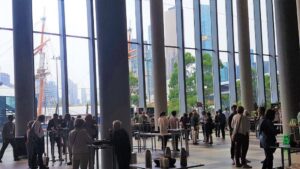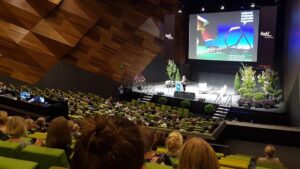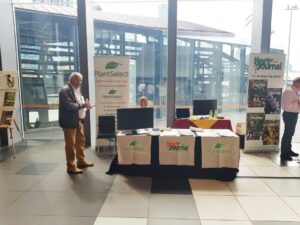
Adaptability of landscapes – A conference with a macro view Part I
By John Fitzsimmons –
Since 1989 The Australian Landscape Conference has sought to inspire, provoke thought and discussion, and take the art and practise of landscaping to amazing places, wherever or whatever they may be. Through a pandemic and a change of ownership, the biennial-ish event recently re-emerged in Melbourne, generating a positive response in-person and online from upwards of 700 participants around the world, and presentations from Japan, Sweden, the UK and USA and, of course, Australia.
While a very Australian event, it has been said there is nothing else quite like it in the world. It was initiated by landscape designer Tony Mugg in 1989 and then run by Warwick and Sue Forge until the 2018 event. A follow-up conference under new owner Fleur Flanery and Placing Nature, was scheduled for 2020. We now all know what a year that was and The Australian Landscape Conference wasn’t the only organisation or event that suffered a COVID-19 year. It was worth the wait, and despite the challenges and travel barriers faced by international presenters, the hybrid (virtual and face-to-face) event, supported by innovative new event management software, worked well in the Melbourne Convention Centre on South Wharf. Even now, although there is an expiry date, attendees can re-live their chosen program moments via online links. The conference program was extended with garden visits and workshops.
As its introductory notes explain, “the conference has consistently striven to seek out the most interesting work in every continent and culture, taking the audience out of what may be described as the ‘comfort zone’ of gardens made in the Anglo-sphere. In the process, it has been striking to see how global trends and preoccupations can be discerned across disparate cultures”.

With such a wide-ranging and eclectic brief, it is similarly challenging to report in a formal way just what attendees experienced and what non-attendees missed out on. What any one delegate took away from this event was probably a very individually-oriented new idea or perspective or reference. There were some common themes among the presenters, yet also some challenging and discordant observations. If you came to this conference expecting yet another list of ‘how to’ classes you probably had to re-adjust your thinking early on.
Warwick Forge once observed that: “What gardens should not be is a battle against the local climate”. Prophetic words. In 2021, conference presenters were to make numerous references to climate, some general in nature and others scarily objective, tying in with the event’s theme of ‘Adaptability of Landscapes’. At an extreme, one presentation suggested that, based on the current rate and pattern of global climate change, any plant palette intended for a public or civic landscape design in Melbourne several decades hence should be based on one applicable to Dubbo (NSW) some 800km north, today!
While the mainstream horticulture and landscaping communities now broadly recognise and accept human enjoyment, wellbeing and aesthetic appreciation as being major foundations of the industry, the Landscape Conference considered far wider and deeper considerations. One observation was that a landscape should provide a ‘sense of place’. This thread of thought began with Margo Neale, Head of the Centre for Indigenous Knowledges and Senior Indigenous Curator & Advisor at the National Museum of Australia, and Adjunct Professor at the Australian National University (ANU). Margo opened the conference by acknowledging the indigenous people of the Melbourne region, and developing the idea ‘there is no Nature without Culture’ – the notion of ‘country’ and belonging.

She was followed by Bill Gammage AM. Emeritus Professor and Senior Research Fellow at the ANU Humanities Research Centre. Bill elaborated on the arrival of Europeans in Australia – what they found and how they interpreted it, and contrasted that with what Aboriginal people had done for millennia, and how they related to those actions and history. He pointed out how the European words used, desert, wilderness and bush etc., were “more a statement of mind than of ground”.
“No landscape words were adequate for what they saw.”
“To Aboriginal people, land care was a fundamental duty of life, linking the beginning of creation to the infinite future”, he said.
How the European presence subsequently modified the landscape as it imposed its needs and ideas on it, culminated in modern ‘industrial agriculture’ which the next speaker, farmer, ‘landscape manager’ and writer Charles Massy, decried but explained how it was possible to reverse many of its negative impacts.
He began by highlighting the ‘great acceleration’ since WW2, with dramatic uptrends in socio-economic factors (e.g. total population, urban population, water use etc.) mirrored in earth system trends (e.g. carbon dioxide levels, stratospheric ozone levels, ocean acidification etc). He maintains industrial agriculture is the major player in damaging seven of the world’s nine ‘threatened planetary boundaries,’ including biodiversity loss, fresh water use and land system change. So, he went on, “there are grounds for hope. If poor land use is a major causal factor, then regenerative land use/design is a key solution”.
Part of the way forward is to “regain ecological literacy”, Charles said. The “current industrial paradigm sees nature as the enemy, to be simplified, dominated and, if necessary, killed”, he added.
Our landscapes and our gardens are ‘Complex Adaptive Systems’ which can be simplified or enabled in their function, he explained. Healthy landscapes are built around five key landscape functions: solar function, the water cycle, the soil-mineral cycle, dynamic ecosystem communities (biodiversity), and human-social factors, all directly interconnected. Recently advanced grazing systems to accommodate this, combine both crops and grazing animals and a dozen or more plant species at a time.
Later in the conference Philip Cox AO, himself a designer of several large projects including Yulara (NT), linked back to these ideas when describing his own project on the New South Wales south coast. He recalled how the Yulara project prompted closer consideration of what really is a “desert”, what was native and what was exotic, what marvellous plants grew there.
When he first went to Central Australia he said, “I saw a garden – a complete garden”.
His work on urban projects including Sydney Football Stadium (since demolished!), Melbourne Park and the MCG, brought him into contact with landscape architects and how to integrate buildings into the landscape itself. Even large-scale buildings must sit comfortably in the landscape, he commented, which led to the question ‘when you look at this landscape, what feeling does it engender in you? What is spirit of place?’ Inserting a building or a sculpture into the landscape can give it “additional meaning, a poetry” that was not there before. The structure that replaced the Sydney Football Stadium, in Philip’s view, has no spirit of place.
He expressed concern at the lack of history, an important part of our culture, being taught in our schools of architecture and landscape. Philip’s own historical inspiration, he said, came from William Kent (1685-1748) a pioneer of the ‘natural’ and ‘informal English garden’ styles, seeing “all nature (as) a garden”. Philip used Kent’s work at Rousham House as an example, where the actual area was modest and yet the open and natural design made the property appear so much larger. He also included the work of Lancelot ‘Capability’ Brown and Humphry Repton as historical inspirations.
Closer to home, Philip acknowledged the advice of Christina Kennedy “not to plant the bush but reveal it” when it came to his coastal retreat ‘Thubbul’ near Bermagui (NSW). The site is bordered by coast and the mouth of the Murrah River. The ‘Australian garden’ has different botanic ‘realms’, including a coastal zone, paperbark and spotted gum forest, a rainforest gully and a dry sclerophyll forest. The spaces appear natural, “discreetly edited for aesthetic pleasure”. Indigenous plants were reintroduced to places they previously inhabited, invasive weeds removed and tree plantings modified to create vistas and patterns of light.

Upon purchase in the 1960s, the site was ex-farmland left in a fallow unproductive state, with a few Banksia integrifolia, Eucalyptus botryoides (Woollybutt) and “just rank grass”. The garden was developed by adding bodies of water and planting new native material, including Corymbia maculata (spotted gum) and Eucalyptus haemastoma (Scribbly gum). A series of walled gardens provide protection against salt and wind. Few exotics were used as they simply don’t survive. Sculptures give definition and points of interest. Some low horizontal brick walls accent the verticals of the tree trunks. A few lawn areas for passive visitor recreation were created from the failed agricultural grassed pockets.
Against this background of historical landscape, concepts and linkages of landscapes to the environment, other speakers came closer to the more everyday concerns of landscape architects and designers although ultimately, the environment is inescapable.
When you get commissions in places as diverse as the UK, the Caribbean and Morocco, the demands and expectations of the clients can vary just as much or more. In a virtual presentation, Tom Stuart-Smith described several such projects. Notably, each was ultimately anchored to the local environment and community. Tim noted that in the 1800s, the water table at Marrakesh was only 2m down, it is now 20m below the surface! Admittedly, the Mustique project was necessarily somewhat artificial although it did provide opportunity for ‘a landscape without boundaries’.
Dr Sue Stuart-Smith, psychiatrist and author of the book ‘The well gardened mind’ provided some firsthand and compelling experience in the therapeutic and wellbeing benefits of gardens (a topic Hort Journal Australia has championed for some time). She referenced Sigmund Freud who observed “beauty can’t protect us from damage but it can compensate us for a lot.”
Dr Stuart-Smith pointed out that our levels of anxiety and depression are rising and asked how we got to this point? She partly attributed it to a loss of community and social isolation, and a disconnect from nature.
“The inner and outer worlds can come together in a garden (and) can put us absolutely in touch with the cycle of life,” she said.
In the UK, Sue is involved with Horatio’s Gardens, a project which has seen special gardens constructed for patients with spinal injuries. Both the patients and their visitors are buoyed by visiting the gardens, whether still bed-ridden or confined to wheelchairs. She also reported significant reductions in recidivism following the introduction of jail gardens for inmates at Rykers Island and San Quentin (USA).
While this report has thus far covered a good part of the Australian Landscape Conference 2021’s program, there was richness in the remainder of the program which must wait for a report Part 2, but it is fair to flag some of the key messages still to come out of Melbourne. These include:
- The importance of groundcovers for biodiversity in future landscape designs
- Why landscape architects and designers should work with the propagation side of the industry to provide the best species for creative, diverse and successful projects
- Just why there is such a great divide between private and civic designs and plantings in Australia
- The continuing debate on natives vs exotics on the plant palette
- Avoiding the concept of ‘maintenance’ in favour of the words, ‘management’ or ‘care’ in landscaping tenders
- A ‘trifecta of plant selection’ – Claudia West’s magic triangle
Stay tuned!
